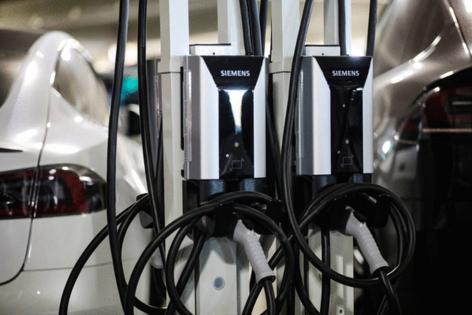Fuel economy standards rewrite poised to deal a blow to EVs
Published in News & Features
Electric vehicle advocates are bracing for the Trump administration’s anticipated reversal of the coupling more than a decade ago of vehicle fuel economy standards with EPA goals to reduce tailpipe emissions.
The Transportation Department’s upcoming rewrite of Corporate Average Fuel Economy (CAFE) standards — paired with the 2025 reconciliation law’s elimination of fines for not meeting the standards, rollback of EV tax credits and other reversals of long-standing emissions rules — is expected to further water down federal support for the EV market.
“All of these things combined will have some impact on the deployment of EVs in the near term,” Albert Gore, executive director of the Zero Emission Transportation Association, said in an interview. “And these are difficult investments to make.”
The CAFE standards, which require automakers to meet an average fuel economy level for all the cars and light trucks they sell in a model year, were established in 1975 to reduce the nation’s reliance on foreign oil and ease costs for consumers in response to the 1973 oil embargo.
The EPA changed that in 2009 with its endangerment finding, a determination that greenhouse gas emissions pose a public health threat and thus need to be regulated by the agency. The finding gave the EPA the authority to regulate vehicle tailpipe emissions.
Jeff Alson, a former EPA senior engineer and policy adviser who helped establish the vehicle emission regulations, said EPA then worked with the DOT to “harmonize” tailpipe emission and CAFE standards to ease the impact on automakers.
Manufacturers could get credit for each EV they sell in a model year, bringing up the average fuel economy for all vehicles sold that year. Companies whose fleets fell short of the CAFE standard could face big fines.
“(Automakers) can kind of meet them with the same kind of technologies,” Alson said. “Even though they were different laws and had different objectives and all that, in terms of the impacts on the manufacturers, they were pretty much the same.”
But the Trump administration appears poised to change both sides of the balance: tailpipe emissions rules and the fuel economy standard that helps meet those rules.
The administration in June released an interpretive rule that prohibited the National Highway Traffic Safety Administration, the agency that sets CAFE standards, from considering “alternative fuel” vehicles, like EVs and hydrogen-powered vehicles, and associated credits when setting the standards — a move that essentially decouples NHTSA’s CAFE standards from EPA tailpipe standards, in theory making it much harder to achieve either. But the likely end to tailpipe standards, expected next year, and the lowering of CAFE standards will ultimately make it easier for the manufacturers.
Republicans in Congress and some automakers, who lauded delinking, say the Biden administration’s ratcheting up of the goals unfairly pushed automakers toward producing more EVs and eliminated consumer choice.
“This is a positive development and important clarity from the Department of Transportation,” the Alliance for Automotive Innovation, a trade association for car makers, said in a statement about the interpretive rule. “In multiple comments to NHTSA during the Biden administration, automakers said NHTSA’s standards were ‘improperly predicated’ on alternative fuel vehicles.”
‘Historic’ reversals
The Trump administration has already taken steps to reverse the Biden administration’s EPA tailpipe emissions standards and the endangerment finding on which the rules are based.
“The first Trump administration didn’t even dream of wiping out all the standards,” Alson said. “They were just going to weaken them and slow them down. This is really historic, wiping them off the books.”
Alson added that reversing the linkage between CAFE and EPA standards is an easy target, too, since there’s no formal legal or statutory mandate to use fuel economy standards to address tailpipe emissions.
“It was always a linkage based on common sense,” he said. “It’s just a basic scientific fact … every time you burn a balance of a gallon of gasoline, you’re going to get about 20 pounds of carbon dioxide. That’s how people like me ended up linking them under the Obama administration and the Biden administration.”
Impact on EVs
The EV market, having grown over the past few years thanks in part to the EV tax credit and Biden administration regulations, has slowed since Republicans took control of Congress and the White House.
Ford Motor Co. CEO Jim Farley said in Detroit in September, just before the EV tax credits were set to expire, that he “wouldn’t be surprised” if EV sales fell to a market share of 5 percent after the credit ended from around 10 percent to 12 percent at the time.
Ellen Hughes-Cromwick, senior visiting fellow in the climate and energy program at the left-center think tank Third Way and a former chief economist at both Ford and the Commerce Department, said in an email that she had estimated the EV industry would reach a 50 percent market share by 2030 with the tax credits and other federal incentives.
Now, she estimates 30 percent could be ambitious, especially in light of rising risks of recession during the second half of this decade.
“Our legacy automotive companies are incorporating new headwinds and tailwinds. For headwinds, the elimination of EV tax credits for vehicle buyers has incentivized a shift to delay or even cancel EV product plans,” Hughes-Cromwick said. “At the same time, easier regulations on fuel economy and emissions looks like it incentivizes the companies to amp up profitable SUV and truck production.”
She added that “only time will tell” on the prognosis as automakers await finalized CAFE standards, emission regulations and tariff policy.
In spite of slowing EV growth and rollback of federal support, Gore estimates global demand for EVs will still drive market interest in the United States.
“The CAFE standard is not necessarily meant to push the ceiling higher but to raise the floor and ensure that automakers who are not moving quickly to manufacture in high volumes lots of fuel-efficient vehicles are nonetheless continuing to improve over time,” Gore said.
According to an International Energy Agency outlook in May, EV sales topped 17 million worldwide in 2024, rising by more than 25 percent. China continued to dominate the market.
“The return on the invested capital, although there’s less of it out there, which makes it a bit riskier from a cost of capital perspective, is much higher. It’s because the market is less competitive, but there is a lot of demand,” Gore said. “I think people don’t want to be left out of technological innovation and a vision of the future.”
©2025 CQ-Roll Call, Inc., All Rights Reserved. Visit cqrollcall.com. Distributed by Tribune Content Agency, LLC.







Comments